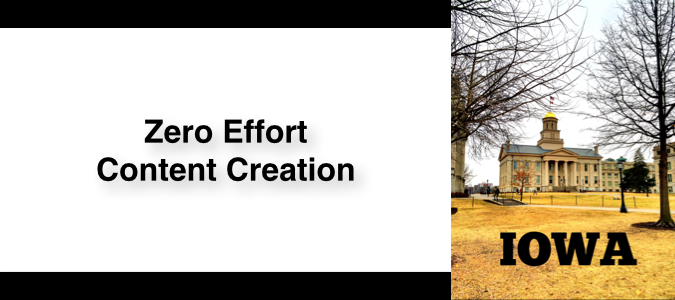
People sometimes ask me how I’m able to write so many articles. The secret to posting a lot of content online is to have it be part of your workflow.
I call this zero-effort content creation because it’s writing that’s already being developed as part of a person’s daily work and communications.
Here are some examples of what I mean.
- Email. Quite often, when I receive an email from someone, it’s a request to research something, solve a problem, or provide instructions for a certain task. The web is actually a better platform to answer questions since it’s easier to link to other websites, include images, and embed videos. It’s easy to update a web page with corrections or more up-to-date information as needed. A simple email just does’t offer these benefits.
- Notebook / Journal. I regularly keep a journal of the work I do. Sometimes, I document a process, workflow, or solution. Most of the time, these can be written as articles and posted online. It helps me to have these readily available for future reference. A benefit of documenting and following a workflow is that one is always mindful of improvements. With any process, there may be additional steps, or revisions in the order, that make a difference.
- Problem Solving. Whenever I stumble on technical quandaries that involve significant research, I like to document those. Often, if it’s a problem that nobody else has solved yet, such articles become quite popular. A world-wide search on Google may yield that article as the number one search result if nobody else has published on the topic.
- Product Reviews. I often take a significant amount of time to research product purchases for myself or others. When doing so, I like to document my findings before, during, and after a purchase to let others know about product performance. With an article online, it’s easy to provide links to produce manuals and other helpful resources.
- Photography. Smartphone cameras have increased in quality and also in capabilities. As a result, photography has become part of our daily experience. When we see something that’s photo-worthy, we take a picture. With features like HDR (high dynamic range) and panoramic features built-in, it’s possible to take some really interesting photos with a smartphone. As a result, if one takes a bit of time to sort through their daily photos (perhaps reviewing them weekly), it’s possible to end up with a good number of quality photos. These can be shared as is, or used as an artistic background to a page header. For example, the IOWA photo included in the header image for this page was taken in a few seconds and composed while walking to the bus in a few minutes. A simple click and drag created the header image.
Benefits of Open Source Living
One of the benefits of living an open source and transparent live that’s documented online is that others can provide us feedback if they see areas we could improve in.
Benefits of Authentic Content Creation
Creating articles based on real-life needs and experiences works best. A reader can tell if a story was written under pressure to meet a quota or deadline. When you write from the heart, based on personal experiences, without doing so under pressure, the quality of content is much better and much more genuine.
